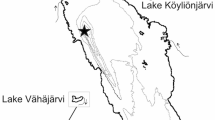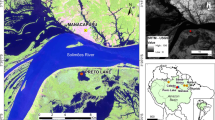Abstract
The sediment record from a 5.3-m core from Sargent Mountain Pond, Maine USA indicates strong co-evolutionary relationships among climate, vegetation, soil development, runoff chemistry, lake processes, diatom community, and water and sediment chemistry. Early post-glacial time (16,600–12,500 Cal Yr BP) was dominated by deposition of mineral-rich sediment, low in organic matter and secondary hydroxides of Al and Fe; pollen indicate tundra conditions; diatom taxa indicate pH between 7.5 and 8, and total P concentrations of about 25 μg L−1, favoring higher productivity. Chemical weathering was rapid, with high alkalinity, pH, Ca, and P in runoff. As climate ameliorated, about 12,500 Cal Yr BP, forest vegetation became established; soils would have developed vertical zonation, including organic matter accumulation, and incipient podzolic horizons, with accumulating secondary hydroxides of Al and Fe that sequestered P in the soils. Labile minerals (primarily apatite, Ca5(PO4)3(OH,F,Cl)) became depleted in the soil, further reducing the supply of P to the lake. Dissolved organic carbon (DOC) from soil organic matter mobilized Al and Fe to the lake where Al(OH)3 (primarily) and Fe(OH)3 (minor) were precipitated. The sedimenting hydroxides adsorbed P from the water column, further reducing bioavailable P. These long-term trends of moderating climate, and changing terrestrial biology, soils, and aquatic chemistry and phytoplankton were interrupted by the 1,000-year long Younger Dryas cooling, which led to a temporary reversal of these processes, a period that ended with the major onset of Holocene warming. The sequestration of P by soils would have strengthened because of long-term soil acidification and pedogenesis. The lake was transformed from a more productive, high P, high pH, low DOC system into an oligotrophic, relatively low P, acidic, humic lake over a period of 16,600 years, a natural trend that continues. In contrast to many human-affected lakes that become increasingly eutrophic, many lakes become more oligotrophic during their history. The precursors for that are: (1) absence of human land-use in watersheds, (2) bedrock lithology and soil with a paucity of soluble Ca-rich minerals, and (3) vegetation that promotes the accumulation of soil organic matter, podzolization, and increased export of metal-DOC complexes, particularly Al.




Similar content being viewed by others
References
Birks HJB (1995) Quantitative paleoenvironmental reconstructions. In: Maddy D, Brew JS (eds) Statistical modeling of quaternary science data. Cambridge University Press, Cambridge, pp 161–254
Birks HH, Birks HJB (2006) Multi-proxy studies in palaeolimnology. Veget Hist Archaeobot 15:235–251
Blaauw M (2010) Methods and code for ‘classical’ age-modelling of radiocarbon sequences. Quat Geochron 5:512–518
Blaauw M, Christen JA (2005) Radiocarbon peat chronologies and environmental change. Appl Statist 54:805–816
Borns HW Jr, Doner LA, Dorion CC, Jacobson GL Jr, Kaplan MR, Kreutz KJ, Lowell TV, Thompson W, Weddle TK (2004) The deglaciation of Maine, USA. In: Ehlers J, Gibbard PL (eds) Quaternary glaciations—extent and chronology, part II: North America. Elsevier, Amsterdam, pp 89–109
Boyle JF (2007a) Loss of apatite caused irreversible early Holocene lake acidification. Holocene 17:539–544
Boyle JF (2007b) Simulating loss of primary silicate minerals from soil due to long-term weathering using ALLOGEN: comparison with soil chronosequence, lake sediment and river solute flux data. Geomorph 83:121–135
Camburn KE, Charles DF (2000) Diatoms of low-alkalinity lakes in the northeastern United States. Acad Natl Sci Phila Spec Publ 18
Chapin FS, Wlaker LR, Fastie CL, Sharman LC (1994) Mechanisms of primary succession following deglaciation at Glacier Bay, Alaska. Ecol Mon 64:149–175
Cooper WS (1923a) The recent ecological history of Glacier Bay, Alaska: I. The interglacial forests of Glacier Bay. Ecol 4:93–130
Cooper WS (1923b) The recent ecological history of Glacier Bay, Alaska: II. The present vegetation cycle. Ecol 4:223–246
Crocker RL, Major J (1955) Soil development in relation to vegetation and surface age at Glacier Bay, Alaska. J Ecol 43:427–448
Davis RB, Jacobson GL Jr (1985) Late-glacial and early post-glacial landscapes in northern New England and adjacent Canadian regions. Quat Res 23:341–368
de Vincente I, Huang P, Andersen FØ, Jensen HS (2008) Phosphate adsorption by fresh and aged aluminum hydroxide. Consequences for lake restoration. Environ Sci Technol 42:6650–6655
Denton GH, Hughes TJ (1981) The last great ice sheets. Wiley Interscience, New York, p 484
Engstrom DR, Fritz SC (2004) Coupling between primary terrestrial succession and the trophic development of lakes at Glacier Bay, Alaska. J Paleolim 35:873–880
Engstrom DR, Wright HE Jr (1984) Chemical stratigraphy of lake sediments as a record of environmental change. In: Haworth EY, Lund JWG (eds) Lake Sediments and Environmental History. University of Minnesota Press, Minneapolis, pp 11–67
Engstrom DR, Fritz SC, Almendinger JE, Juggins S (2000) Chemical and biological trends during lake evolution in recently deglaciated terrain. Nature 408:161–166
Fægri K, Iversen J, Kaland PE, Krzywinski K (1989) Textbook of pollen analysis. Wiley, Chichester
Fastie CL (1995) Causes and ecosystem consequences of multiple pathways of primary succession at Glacier Bay, Alaska. Ecol 76:1899–1916
Fritz SC, Engstrom DR, Juggins S (2004) Patterns of early lake evolution in boreal landscapes: a comparison of stratigraphic inferences with a modern chronosequence in Glacier Bay, Alaska. The Holocene 14:828–840
Ford MSJ (1990) A 10, 000-Yr history of natural ecosystem acidification. Ecol Mon 60:57–89
Gilman RA, Chapman CA, Lowell TV, Borns HW Jr (1988) The geology of Mount Desert Island: Maine. Geol Survey Bull 38:50
Ginn BK, Cumming BF, Smol JP (2007) Diatom-based environmental inferences and model comparisons from 494 northeastern North American lakes. J Phycol 43:647–661
Guidry MW, MacKenzie FT (2003) Experimental study of igneous and sedimentary apatite dissolution: control of pH, distance from equilibrium, and temperature on dissolution rates. Geochim Cosmochim Acta 67:2949–2963
Hieltjes AHM, Lijklema L (1980) Fractionation of inorganic phosphates in calcareous sediments. J Environ Qual 9:405–407
Jacobson GL Jr, Birks HJB (1980) Soil development on recent end moraines of the Klutan Glacier, Yukon Territory, Canada. Quat Res 14:87–100
Jacobson GL Jr, Bradshaw RHW (1981) The selection of sites for paleovegetational studies. Quat Res 16:80–96
Jacobson GL Jr, Webb T III, Grimm EC (1987) Patterns and rates of vegetation change during the deglaciation of eastern North America. In: Ruddiman WF, Wright HE Jr (eds) North America during deglaciation. The geology of North America, DNAG v. K3. Geological Society of America, Boulder, pp 277–288
Kopáček J, Borovec J, Hejzlar J, Ulrich K-U, Norton SA, Amirbahman A (2005) Aluminum control of phosphorus sorption by lake sediments. Environ Sci Tech 39:8784–8789
Kopáček J, Marešová M, Norton SA, Porcal P, Veselý J (2006) Photochemical source of metals for sediments. Environ Sci Tech 40:4455–4459
Kopáček J, Marešová M, Hejzlar J, Norton SA (2007) Natural inactivation of phosphorus by aluminum in pre-industrial lake sediments. Limnol Oceanogr 52:1147–1155
Kopáček J, Hejzlar J, Kaňa J, Norton SA, Porcal P, Turek J (2009) Trends in aluminium export from a glaciated mountain area to surface waters: Effects of soil development, atmospheric acidification, and nitrogen-saturation. J Inorg Biochem 103:1439–1448
Krammer K, Lange-Bertalot H (1986–1991) Susswasserflora von Mitteleuropa. Bacilloriophyceae, Vol I–IV. Stuttgart Gustav Fischer Verlag
Lindbladh M, Jacobson GL Jr, Schauffler M (2003) The postglacial history of three Picea species in New England, USA. Quat Res 59:61–69
Lowell TV (1980) Late Wisconsin ice extent in Maine: evidence from Mount Desert Island and the Saint John River area. Unpub. M.Sc. Thesis, University of Maine
Lundström US, van Breeman N, Bain D (2000) The podzolization process. A review. Geoderma 94:91–107
Monteith DT, Stoddard JL, Evans CD, de Wit HA, Forsius M, Høgasen T et al (2007) Dissolved organic carbon trends resulting from changes in atmospheric deposition chemistry. Nature 450:537–540
Mortimer CH (1941) The exchange of dissolved substances between mud and water in lakes. J Ecol 29:280–329
Murphy J, Riley JP (1962) A modified single solution method for determination of phosphate in natural waters. Anal Chim Acta 27:31–36
Navrátil T, Rohovec J, Amirbahman A, Norton SA, Fernandez IJ (2009) Controls of natural amorphous aluminum hydroxide on sulfate and phosphate anions in sediment-solution systems. Water Air Soil Poll 201:87–98
Nodvin SC, Driscoll CT, Likens GE (1986) The effect of pH on sulfate adsorption by a forest soil. Soil Sci 142:69–75
Norton SA, Wilson T, Handle M, Osterberg EC (2007) Atmospheric deposition of cadmium in the northeastern USA. App Geochem 22:1217–1222
Norton SA, Coolidge K, Amirbahman A, Kopáček J, Bouchard RJ (2008) Speciation of Al, Fe, and P in recent sediment of three Maine lakes, USA. Sci Tot Environ 404:276–283
Norton SA, Perry RH, Saros J, Jacobson GL Jr, Fernandez IJ, Kopáček J, SanClements M, Wilson TA, Pierret-Neboit MC, Lesser DF (2010) Early post-glacial and Holocene history of the Sargent Mountain Pond watershed, as seen from the bottom of Sargent Mountain Pond, Acadia National Park, Maine: New England Intercollegiate Geological Conference, Orono, Maine. pp A4-1–A4-16
Osberg PH, Hussey AM, Boone GM (1985) Bedrock geologic map of Maine. 1:250,000. Department of Conservation, Maine Geological Survey
Psenner R, Boström B, Dinka M, Petterson K, Pucsko R, Sager M (1988) Fractionation of phosphorus in suspended matter and sediment. Arch Hydrobiol, Beih Ergebn Limnol 30:98–103
Renberg I (1990) A 12, 600 year perspective of the acidification of Lilla Öresjön, southwest Sweden. Phil Trans Roy Soc London B327:357–361
SanClements MD, Fernandez IJ, Norton SA (2009) Soil and sediment phosphorus fractions in a forested watershed at Acadia national Park, ME, USA. For Ecol Manag 258:2318–2325
Schauffler M, Jacobson GL Jr (2002) Persistence of coastal spruce refugia during the Holocene in northern New England, USA, detected by stand-scale pollen stratigraphies. J Ecol 90:235–250
Schott J, Berner RA, Sjöberg EL (1981) Mechanism of pyroxene and amphibole weathering–I. Experimental studies of iron-free minerals. Geochim Cosmoch Acta 45:2123–2135
Stuiver M, Reimer PJ (1993) Extended 14C data base and revised CALIB 3.0 14C age calibration program. Radiocarbon 35:215–230
Thompson WB, Borns HW Jr. (1985) Surficial Geologic Map of Maine. 1:250,000. Department of Conservation. Maine Geological Survey
Whitehead DR, Rochester H Jr, Rissing SW, Douglass CB, Sheehan MC (1973) Late glacial and postglacial productivity changes in a New England pond. Science 181:744–747
Whitehead D, Charles DF, Jackson ST, Reed SE, Sheehan MC (1986) Late-glacial and holocene acidity changes in Adirondack (NY) lakes. In: Battarbee RW, Davis RB, Merilainen J, Smol JP (eds) Diatoms and lake acidity. Dr W. Junk Publishers, Dordrecht, pp 251–274
Wilson TA, Norton SA, Lake B, Amirbahman A (2008) Sediment geochemistry of Al, Fe, and P for two oligotrophic Maine lakes during a period of acidification and recovery. Sci Tot Environ 404:269–275
Wilson TA, Amirbahman A, Norton SA, Voytek MA (2010) Sedimentary phosphorus dynamics in oligotrophic lakes. J Paleolimn 44:279–294
Wright HE Jr (1991) Coring tips. J Paleolim 6:37–49
Acknowledgments
Our research was supported by National Science Foundation grants DEB-0415348 and DEB-0414144 to Norton and Fernandez, respectively, and by a gift from Nestlé Waters of North America to Norton. We greatly appreciate the support of staff at Acadia National Park. John Cangelosi, Ben Gross, David Huntress, and Cindy Loften assisted in coring. Processing of the core at the University of Maine was by Andrea Nurse, Robert Harrington, and Samuel Roy. Bekka Brodie provided excellent analytical capabilities. We thank Brian Ginn for applying the pH and total phosphorus models to our fossil diatom data. Richard Bindler kindly provided us with output from the CLAM chronology model (Blaauw 2010). We appreciate the thoughtful, thorough, and constructive reviews of John A. Boyle and one anonymous reviewer, who patiently offered excellent advice on two iterations. Their suggestions substantially improved the clarity of our presentation, and allowed us to correct errors and sharpen the science.
Author information
Authors and Affiliations
Corresponding author
Electronic supplementary material
Below is the link to the electronic supplementary material.
Rights and permissions
About this article
Cite this article
Norton, S.A., Perry, R.H., Saros, J.E. et al. The controls on phosphorus availability in a Boreal lake ecosystem since deglaciation. J Paleolimnol 46, 107–122 (2011). https://doi.org/10.1007/s10933-011-9526-9
Received:
Accepted:
Published:
Issue Date:
DOI: https://doi.org/10.1007/s10933-011-9526-9




